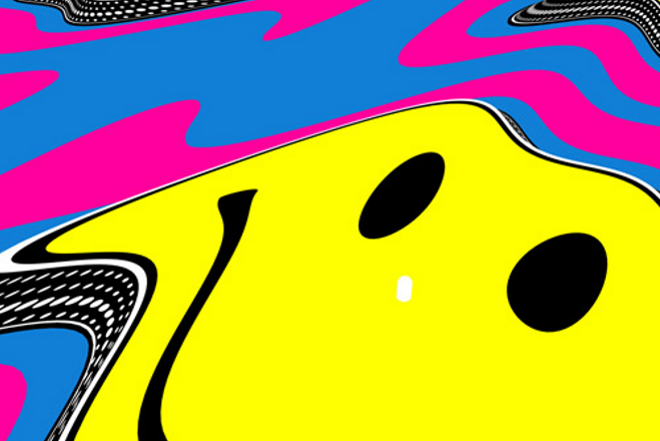What embodies the acid house aesthetic – the sounds or the period in time? Any piece examining the era in U.K. dance music history from roughly 1986 to 1992 targets club and youth culture, touching on how the sounds and word-of-mouth warehouse parties overlapped with the Second Summer of Love and eventually dissipated due to police crackdowns and stronger club regulations. However, if the sounds from the period – minimal, on-the-beat-rhythms with a swinging feel, and those distinctive Roland TB-303 squelches and grooves – never materialized, would the culture and movement that received so much media attention have existed?
It’s hard to say, but the style first originating in Chicago and then coming over to Europe, and then later mainstreamed by 808 State, S’Express, and other U.K. acts ultimately provided the fuel. However, if the stronger club regulations put in place in the U.K., rather than just sonic evolution, killed acid house’s mainstream ascent, could those same sounds exist in a far more sanitized world of big room singles, mega dance music events with a strong security presence, and clubs where the DJ plays it safe?
We’re finding out about that now. Singles in 2014 – particularly those from artists not fully mainstream but not existing solely in the underground, either – have attempted to bring back the character and vibe, creating in the process a nu-acid house that merges with big room in many cases but keeps the quintessential elements in place. At points, it’s awkward, as if producers are attempting to revive something without losing their mainstream credibility. At others, the move replicates similar dance music trends of repackaging retro sounds into something seemingly new – but innovative only to those who don’t remember the original sounds.
But before determining what works and doesn’t or eviscerating Tiesto for even attempting an acid track, what, exactly, was acid house?
 Just like few can pin-point the origins of other ‘80s dance music subgenres like freestyle and synthpop, acid house has ambiguous beginnings attributed to the Chicago scene. The first official cut – and the one from which the subgenre likely earned its name – was “Acid Tracks,” from Phuture. Others claim the name references acid rock, the use of drugs, or British slang for “acid burning,” as tracks from this period sampled heavily.
Just like few can pin-point the origins of other ‘80s dance music subgenres like freestyle and synthpop, acid house has ambiguous beginnings attributed to the Chicago scene. The first official cut – and the one from which the subgenre likely earned its name – was “Acid Tracks,” from Phuture. Others claim the name references acid rock, the use of drugs, or British slang for “acid burning,” as tracks from this period sampled heavily.
Although pre-“Acid Tracks” singles fit the vibe, the use of the Roland TB-303 to create that squelch sound and “swinging” rhythmic pattern make this particular cut the one that officially started it all in the U.S. But while sales of acid house – and generally, all house music singles – declined toward the end of the ‘80s, the sounds were picked up and ultimately flourished in the U.K.
Just like in the U.S., how acid house spread across the ocean and into U.K. clubs is still debated, with some saying that Paul Oakenfold, Danny Rampling, Nicky Holloway, and Johnny Walker heard DJ Alfredo play them in Ibiza and then took them back to U.K. clubs like Shroom and Trip, while others cite the popularity of Hacienda night Nude, where the DJ played dance music from the U.S. to U.K. crowds.
As has been the case with many dance music subgenres, the sounds caught on with a small group, it spread (in those days, by word of mouth rather than social media), and they eventually went mainstream. Aside from creating mega clubs, like Ministry of Sound and Cream, this resulted in tracks like D-Mob’s “We Call It Acieed,” A Guy Called Gerald’s “Voodoo Ray,” and S’Express’ “Hey Music Lover,” “Theme from S’Express,” and “Superfly Guy” charting high in the U.K. – in some cases, even making it into the top 10 singles.
But as we know, mainstream dance music movements don’t last forever – although that doesn’t mean they can’t survive underground. Acid house left more of an impact not so much with its sounds, but with how the DJ is perceived, in changing global club culture, and also in how dance music events and venues are regulated.
But in terms of revisiting acid house, there’s one factor to keep in mind – it didn’t entirely disappear. Some of its players, like Sasha and Paul Oakenfold, moved on toward trance, while Chicago’s DJ Pierre continues to do sets. Finding new yet classic-sounding singles proves to be a challenge, however, but that doesn’t mean they don’t exist. Just looking back at the new releases from underground deep house labels like Baccara Music or Restore Music, you’ll find such tracks as Mehdispoz’s “A Man Lost Inside The Acid House,” Johnny Fiasco’s remix of Mehdispoz’s “Acid Life,” and Peet dafeet’s remix of Cera Alba and Jonny Cade’s “Don’t Want Your Love.”
Falling into the vast scope of underground dance music doesn’t guarantee quality, authenticity, or innovation, contrary to what its supporters claim, and amongst the pure acid house tracks out there are ones that push the envelope a bit too far toward a different subgenre. Sometimes it works, and sometimes it doesn’t.
Out of this distinction – let’s call it “acid influenced” – there’s RFN’s “Hero (Minimal Acid House Extended Mix).” Bare-bones elements merge with a big room character but the vibe becomes timeless: Part modern and part a nod to the past.

A contrast to this is Sully Maydwell’s “Acid Disco.” At first listen, the 150-plus BPM puts it way out of the appropriate groove range and instead transforms it into a hardstyle version of acid house. While this track could easily signal the creation of another hybrid subgenre – acid hardstyle, anyone? – it ultimately feels like a classic record sped up to the point it sounds like the producer’s trolling his audience.
While acid house might not blend well with hardstyle (and really, few styles actually do), that doesn’t mean its distinctive character doesn’t gel well with more modern elements. For instance, SEQU3L’s “Booka Booka” – itself a nod to the modern nightlife around the Indian subcontinent – splices adds the rhythms to what’s a clear deep house track.
Similarly, the chromatic synths and swinging rhythms emerge just as clearly on Eric Sharp & Sir DSS ft. Katxx “And Work!” (Angger Dimas Remix), built with a techno foundation. Like the minimal remixes of “Alphawave” and “Hero,” the carefully selected elements from both the past and present converge into something that’s both retro-referencing and modern.
Ewan Pearson’s remix of Jagwar Ma’s “Uncertainty” attempts to straddle both time periods, as well. The slower, desolate-sounding opening may put off some listeners – after all, most acid house tracks jump right into the familiar feel – but the rhythmic patterns, swinging vibe, and sequencer patterns establish the vintage character midway through. If you can make it to that point, it’s a solid, timeless-sounding track.
Deep house, techno, and minimal subgenres appear to have the sonic foundation for acid house’s classic elements to flourish in a modern context, but what about with progressive house and big room subgenres? The blend isn’t as clear.
For instance, Far Too Loud’s recent Doomsday Machine EP flirts with the rhythms and synths in a big room context – and it surprisingly works. On “Doomsday Machine,” EDM’s uplifting character supports acid house’s similar feel, with chromatic synths, an octave bass line, and pitch distortion cementing the retro character. Far Too Loud then changes it up on “Acid 9000,” opting for the bouncy groove of an acid rhythm, which plays off your run-of-the-mill progressive house crescendos and drops.
Far Too Loud may get the mix right – but too many others can’t find the right balance. Tiesto and MoTi’s “Back to the Acid” loses the classic elements amid a grandiose, all-encompassing big room character; if it weren’t for the robotic vocals, the intentions would’ve been completely lost. Similarly, Danny Howard’s “Apex” rests too much on big room builds to make the pitch distortion elements a clear reference to the past. As well, Finnish producer Huoratron’s “Pioneers of Nothing” gets points for the distortion and discordant character, but drops and an aggressive bass detract from it.
Acid house might be the “it” retro style to emulate for now, but on a mainstream level, we’ll have to see how audiences connect with the influx of new tracks.




